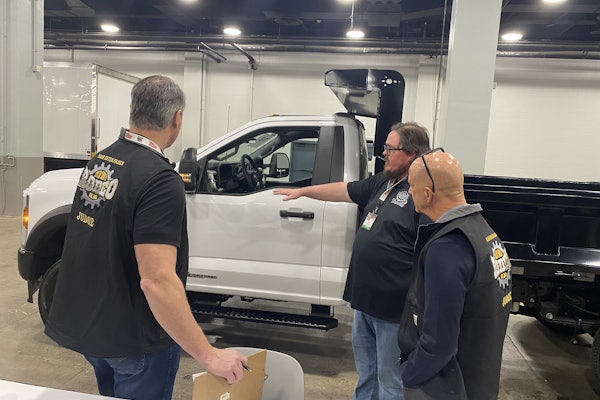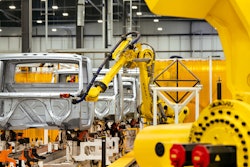Using an object to make it easier to accomplish a task has been part of human behavior for millions of years. Creating an object to help accomplish a goal – sharpening a stone to hunt with, for instance – came later in the evolutionary line, but is still as old as drawing on cave walls.
And while millions of years passed between the sharp-edged stone and the first forged instrument, developments in recent history have advanced quite rapidly.
Particularly the tools of the trade for vehicle service technicians which today provide unparalleled levels of productivity, safety and ergonomics.
Tools have kept pace with the rapid advances in technology during the last 100 years. It wasn’t long after the first gasoline-powered horseless carriage hit America’s dirt, rutted streets that the need to service those vehicles arose, and the corresponding tools to do so.
As vehicles advance technologically, so do the tools, as is evident by the familiar sight of laptops and handheld computers used daily in service shops to diagnose and assist in repairing trucks.
The development of hand tools is no exception.
“If I looked at a technician’s toolbox today, I would find dozens, if not a hundred, specialty tools that would not have been there 25 years ago,” says Carl “Bud” Bolt, who founded Bolt’s Antique Tool Museum about 35 years ago.
Bud and his wife, Laila, donated the museum to the city of Oroville, Calif., about three years ago and now work there as volunteers. The 5,000 square-foot museum opened in a new building in Oroville when the city took ownership and has approximately 8,400 tools on display, about 40 to 50 percent Bolt estimates are from the vehicle service sector.
“The modern tool has made it possible for the technician to perform his work so much faster and safer, and still do higher-quality work,” Bolt says.
Lee Long, director of maintenance for Southeastern Freight Lines and the Technology & Maintenance Council’s Professional Technician Development Committee chairman, has been in the business for about 37 years. Back when he first started, getting a hand tool to ergonomically fit his personal needs required a little modification.
“When I first started out I went and bought tools and within a year’s time I would take them to the vise and bend them and made them to where they would work ergonomically for me and help achieve a specific purpose,” Long says. “Nowadays you can walk onto a specialty tool truck and pick up a wrench and say, ‘that’s exactly for tightening or removing starter bolts from this Thermo King or whatever.’ But back when I first started, that wasn’t always an option; you had to modify what you used.”
TOOL EVOLUTION
Advanced designs, state-of-the-art materials and increased specialization have driven a rapid evolution of technician tools, both manual and air or electric powered.
Jim Boyd, manager of Fleet Technical Services for Southeastern Freight Lines, notes several significant hand tool advances observed while walking around the shop floor.
First on his list are ratchet wrenches. “The teeth are not only much stronger than they were in years past, but there are also more teeth in that 360-degree circle, which means you don’t have to have near as long of a throw to grab another tooth.”
The handles and gripping areas of modern tools are perhaps the most noticeably changed from their predecessors. They are ergonomic to best fit the hand, allowing for a better grip, greater leverage and less slipping. Tools that are used in impact scenarios often have cushioned grips to help minimize shock.
Hammers with synthetic handles, he says, are an improvement over ones with wooden handles. Wood handles splinter, shortening tool life, and possibly leaving splinters in the technician’s hand. The synthetic handles are also better at absorbing shock.
While air- and electric-powered tools came into widespread use about 50 years ago – leading to significant productivity gains – modern designs are lighter, more powerful and have greater durability.
“Some of the greatest time savings that have come about during the years is the pneumatic tools and the electric tools,” says Long. “They have helped take a job that used to take eight hours and really minimized it down to six hours.”
Battery power has helped take them to a higher level.
“Battery-powered (cordless/untethered) tools are the future,” says Dave Manka, Snap-on Power Tools product manager. “Especially as their size decreases and power increases. Cordless products already are, and will, continue to become more important because of their versatility.”
He notes that one of the versatile aspects is that a common battery can be used to power several different tools.
“Battery-powered tools have come a tremendous way,” says Boyd. “There are 3⁄8-inch and 1⁄2-inch impact wrenches and drills now that are incredibly efficient, incredibly strong, incredibly durable and can run a very long time on a single charge – and you’re not tied to an air line. You have complete freedom. It’s also a lot less torque on the wrist because the technician isn’t lugging that air line or electrical cord around.”
The power and convenience means increased productivity, as well as less chance of injury.
SAFETY & ERGONOMICS
Perhaps one of the best examples of advances in tool ergonomics may be the creeper. When Long started servicing trucks, it was a simple design – a piece of wood with four wheels on the bottom.
“You go down to the shop now and they’re cushioned and molded to fit your back so your back is comfortable when you’re lying there trying to put a starter up on a truck,” says Long.
These types of design advances, while obvious in retrospect, have helped make the technician safer and less prone to injury by reducing repetitive actions and putting less strain on the body.
Boyd says technician injuries are usually not a pivotal event, but rather an accumulative one. One jolt from the snap of the vise grip doesn’t create injury, but several snaps a day over the course of 20 years will take a toll.
This realization has been growing through the years and will continue to evolve.
“Awareness has been increasing during the past 25 years in large part due to OSHA and other organizations that regulate safety and health in the workplace,” says Jane Kiefhaber, product category director for Grainger. “I would say the most important advantage that ergonomic tools provide is the impact on the long-term health of the employees. The primary goal of the ergonomic tool is to decrease long-term wear and tear on the body of the technician. These tools allow them to miss less time away from work from issues that are caused by lingering long-term health problems related to physical breakdown.”
Adds Scott Amundson, Snap-on Hand Tools product manager, “Ergonomics is always being refined to prevent injury and minimize fatigue. In addition, the advancing age of the average heavy-duty technician, which is currently 48 years, increases the urgency on improved ergonomics.”
The power and productivity gains from today’s powered tools are even more impressive considering their ergonomic advantages.
“One of the biggest changes has been in the size and weight of the tool,” says Dave Manka, Snap-on Power Tools product manager. “For example, older 3/4-inch impact wrenches typically weighed 12 to 13 pounds. Today, through the use of lightweight, one-piece magnesium housing, the MG1200 3/4-inch impact wrench weighs only 8 pounds.”
Lightweight designs that do not sacrifice durability are just one aspect of more ergonomic tools.
“Little things have become important,” says Manka. “Compressed air that flows through a power tool actually makes the surface of a power tool cold to the touch in some areas. Cushion-grip handles are used on many Snap-on power tools to shield the user’s hand from cold and help absorb vibration.”
He adds, triggers have rounded and contoured edges that are covered with cushioned grips to eliminate pinch points and make the tool more comfortable to operate. The angle of the handle in relationship to the body of the tool is closely considered so that the tool is balanced and fits into the user’s hand without it being too heavy in the nose or tail.
The reason for all of this attention to detail?
“One, and probably an overlooked advantage, would be improved morale of employees,” says Kiefhaber. “But the obvious answer would be to cut down on lost work hours due to injury.”
Which translates into reduced potential for legal and insurance-related issues that can accompany workplace injuries.
NO SMALL INVESTMENT
The proliferation of specialty tools is being embraced by technicians in a big way, literally. The financial investment for a fully equipped set of tools is steep and the real estate on the shop floor required to house them all is significant.
According to Long, a technician starting out today would spend about $2,000 to $3,000 on an entry-level set of tools. “And that goes up depending on how big of a toolbox you want to store your tools in,” he says. “It could get quite pricey.”
Long says when shops were designed years ago, the typical toolbox was about 3 feet wide, 3 feet deep and 6 feet high. “You go down on the shop floor now and you see toolboxes 8 feet long, 4 feet deep and 6 feet tall,” he says. “So when it comes to the real estate in the shop, you have to make different allowances in planning for those types of things.”
Even the toolboxes themselves have evolved.
“Toolboxes have certainly come a long way,” says Boyd. “They have improved the handles on the toolboxes, they’ve improved the work surfaces where a technician can lay his items and work and they’ve improved the rollers greatly. It’s a lot easier to move it around the shop, a lot more stable, bigger rollers and locks on the rollers so that you can lock the toolbox so it doesn’t roll away.”
Some toolboxes also have areas specifically for computers, and even built-in stereos and refrigerators.
The level of technician tool sophistication and specialization will continue, because as tool companies say that as long as there’s a need, they’ll fill it. “We are constantly listening to the feedback about what our customers are looking for,” says Kiefhaber. “So we get feedback from our sellers and we also conduct onsite visits ourselves with our product managers. We’re observing how customers are using tools or what their environments are. That gives us an opportunity to identify what gaps we have in our product line and then go back to the manufacturers and either identify the things that we think we should have, or they already do have, and we fill those gaps in our product line.”
And the market is eager for the new product offerings, judging by the technicians’ reactions when the tool truck comes to visit.
“It’s interesting to see the guys go in there and their jaws drop when something new comes out and they’re the first one in the shop to have it,” says Long. “It is, even for me, an older technician. Going into the tool truck, I start salivating myself.”
It may be an understandable reaction and one not without historical precedence, given tools integral role in human industry and industrial progress.
“Everything that we have in this industrialized world is because of man’s ability to make and use tools,” says Bolt. “And the technician is no better than the tools and equipment that he has to work with. The finest technician on Earth, take his tools away and he can’t do a thing.”






